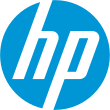
An ultra-mobile PC, or ultra-mobile personal computer (UMPC), is a miniature version of a pen computer, a class of laptop whose specifications were launched by Microsoft and Intel in Spring 2006. Sony had already made a first attempt in this direction in 2004 with its Vaio U series, which was only sold in Asia. UMPCs are generally smaller than subnotebooks, have a TFT display measuring (diagonally) about 12.7 to 17.8 centimetres, are operated like tablet PCs using a touchscreen or a stylus, and can also have a physical keyboard. There is no clear boundary between subnotebooks and ultra-mobile PCs, but UMPCs commonly have major features not found in the common clamshell laptop design, such as small keys on either side of the screen, or a slide-out keyboard.

The Compaq Presario 1200 was a line of notebook computers produced between 1998 and 2000 by Compaq as part of Compaq Presario line.

Asus Eee is a family of products by AsusTek Computer Inc. The product family began with the release of the Eee PC subnotebook in 2007; since then, the product family has diversified into a number of PC form factors. According to the company, the name Eee derives from "the three Es," an abbreviation of its advertising slogan for the device: "Easy to learn, Easy to work, Easy to play".
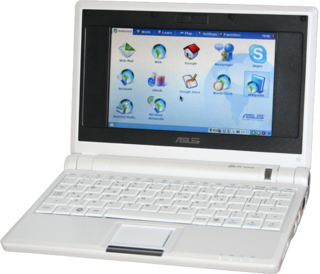
The ASUS Eee PC is a netbook computer line from Asus, and a part of the ASUS Eee product family. At the time of its introduction in late 2007, it was noted for its combination of a lightweight, Linux-based operating system, solid-state drive (SSD), and relatively low cost. Newer models added the options of Microsoft Windows operating system and rotating media hard disk drives (HDD), and initially retailed for up to 500 euros.

Dell Vostro is a line of business-oriented laptop and desktop computers manufactured by Dell aimed at small to medium range businesses. From 2013–2015, the line was temporarily discontinued on some Dell websites but continued to be offered in other markets, such as Malaysia and India.
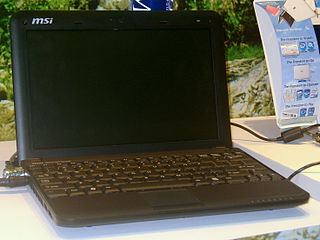
The MSI Wind Netbook was a family of subnotebooks / netbooks designed by Micro-Star International (MSI). Wind stands for "Wi-Fi Network Device". The first model was announced at CeBIT 2008, and first listed for pre-orders on May 9, 2008. While initially 8.9- and 10.1-inch screen versions existed, as of 2010 only the 10.1" remained, with a resolution of 1024 × 600. While most models had 1 GB of RAM, some had 2 GB, and hard disks ranged from 80 GB on the oldest to 250 GB on the newest models. Also featured were Bluetooth, WLAN and a 1.3 megapixel camera. The Wind PC was MSI's response to the successful Asus Eee PC. The keyboard was 92% of full-size.

The HP 2133 Mini-Note PC was a full-function netbook aimed at the business and education markets. It was available with SUSE Linux Enterprise Desktop, Windows Vista or Windows XP. Its retail price started at US$499 for the Linux version with 4GB of flash memory. According to DigiTimes, the netbook was manufactured by Inventec. However, according to APC magazine, it was built by Compal Electronics who also make the MSI Wind and the Dell Inspiron Mini 9. The system was replaced in early 2009 by an upgraded model, the HP Mini 2140, which was also aimed at the education and business market.
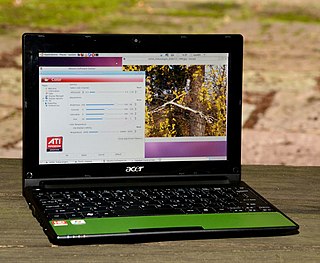
Acer Aspire One is a line of netbooks first released in July 2008 by Acer Inc.

The first netbook offering by Gigabyte, the M912, is a hybrid netvertible Tablet PC device, was released in 2008. It features an Intel Atom processor and comes preloaded with either Windows XP, Windows Vista or a customised Linux distribution. The hardware varies slightly depending on the OS chosen. The Linux Version for example does not include Bluetooth and has a lower resolution screen. Press accounts suggest that there may be significant heat and speed issues compared with other netbooks. Other criticisms focus on Gigabyte's choice to ship one variant with Windows Vista Home Basic, which lacks official Tablet PC support.

The Samsung NC10 is a subnotebook/netbook computer designed by Samsung. At the time of its introduction (2008), it was noted for its combination of a 10.2" screen and large 6-cell battery as standard, giving a battery life of up to 7.5 hours, a large hard disk drive and a release price of 499 USD.
Nvidia Ion was a product line of Nvidia Corporation intended for motherboards of low-cost portable computers. It used graphics processing units and chipsets intended for small products.

HP TouchSmart is a series of tablet PC laptops and touchscreen all-in-one desktop computers designed by HP. It features various Intel or AMD processors and runs Windows Vista or Windows 7 as standard.

The Sony Vaio P series is a range of ultraportable subnotebook computers launched in January 2009.
The Dell Inspiron Mini Series is a line of subnotebook/netbook computers designed by Dell. The series was introduced in September 2008 amidst the growing popularity of low-cost netbook computers introduced by competitors.

The Acer AspireRevo was a line of nettop computers from Acer Inc., first released at the end of April 2009. It is one of the first desktop computers to pair the NVIDIA ION chipset with Intel's Atom CPU.

The IdeaPad S12 is a line of consumer-oriented netbook computers designed by Lenovo. It is a model in the IdeaPad series and their first netbook to have a 12" screen. The computers were put on the market in 2009 and currently come in black and white.
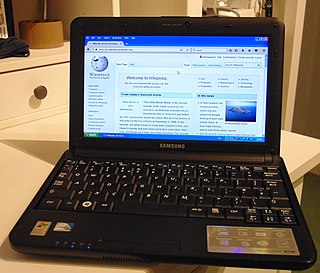
The Samsung N130 is a subnotebook/netbook computer designed by Samsung. At the time of its introduction, it was noted for a good keyboard, large 6-cell battery as standard, giving a battery life of up to 7.5 hours a medium 160gb SATA hard disk drive and a release price of 349 USD.

The IdeaPad S Series is a series of notebook computers launched by Lenovo in October 2008. The IdeaPad S10 was initially scheduled for launch in September, but its release was delayed in the United States until October.
The HP Envy is a line of consumer-oriented high-end laptops, desktop computers and printers manufactured and sold by HP Inc. They started as a high-end version of the HP Pavilion line.

The Dell Inspiron series is a line of laptop computers made by American company Dell under the Dell Inspiron branding. The first Inspiron laptop model was introduced before 1999. Unlike the Dell Latitude line, which is aimed mostly at business/enterprise markets, Inspiron is a consumer-oriented line, often marketed towards individual customers as computers for everyday use.























